Temple of Heaven (Tiāntán 天坛) is Beijing’s largest and most popular temple. It is one of the top things you must do when visiting Beijing.
Temple of Heaven was used by emperors from Ming and Qing dynasties to worship God of Heaven and to offer sacrifices with the hope of bumper harvests.
Temple of Heaven has an inner part and outer part, divided by a wall. The inner part contains most of the structures, such as Hall of Prayer for Good Harvests, Imperial Vault of Heaven, Circular Mound Altar and Abstinence Palace. Meanwhile, the outer part contains the Divine Music Administration where musicians and dancers rehearsed for ceremonies during Ming and Qing dynasties.
Within Temple of Heaven complex, there are a total of 92 ancient buildings with 600 rooms. It is the most comprehensive imperial sacrificial building complex in China that still exists today, and the world’s largest building complex for offering sacrifice to heaven that’s still standing up to this day.
In this article, I will share important travel information and tips you need to know before visiting Temple of Heaven, based on my own experience visiting the temple recently.
Temple of Heaven Opening Hours
Temple of Heaven is open daily, all-year round. However, THE attractions are open from Tuesday to Sunday (closed on Monday, except Public Holidays).
| High Season (1 Apr – 31 Oct) | Low Season (1 Nov – 31 Mar) |
|---|---|
| Gate Open: 6am | Gate Open: 6.30am |
| Gate Last entry: 9pm | Gate Last entry: 9pm |
| Gate Close: 10pm | Gate Close: 10pm |
| Main attractions operating hours: 8am – 5.30pm | Main attractions operating hours: 8am – 4.30pm |
| Audio guide: 8.15am – 5pm | Audio guide: 8.15am – 5pm |
Temple of Heaven Entrance Fee
| High Season (1 Apr – 31 Oct) | Low Season (1 Nov – 31 Mar) |
|---|---|
| Admission ticket: RMB 15 | Admission ticket: RMB 10 |
| Through ticket (Entrance + Hall of Prayer for Good Harvests, Circular Mound Altar & Echo Wall): RMB 34 | Through ticket (Entrance + Hall of Prayer for Good Harvests, Circular Mound Altar & Echo Wall): RMB 28 |
| Divine Music Administration: RMB 10 | Divine Music Administration: RMB 10 |
| Audio guide (Chinese): RMB 20 + RM 50 refundable deposit | Audio guide (Chinese): RMB 20 + RMB 50 refundable deposit |
| Audio guide (Foreign): RMB 40 + RM 50 refundable deposit | Audio guide (Foreign): RMB 40 + RMB 50 refundable deposit |
Note: Remember to bring your passport! You’ll need it to buy tickets!
During our visit, we purchased the ticket directly from the counter and paid with cash. There was a line, but it wasn’t that long, we waited for maybe about 15 minutes. Your experience may vary. If you’re worried about the long line at ticket counter, you can purchase online ticket in advance.
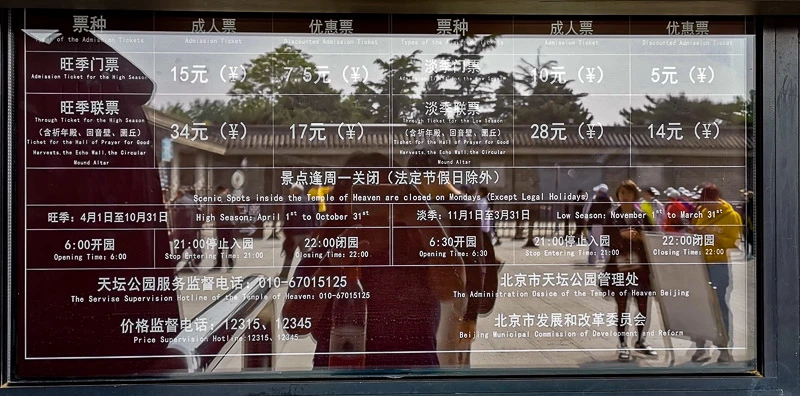
Getting to Temple of Heaven
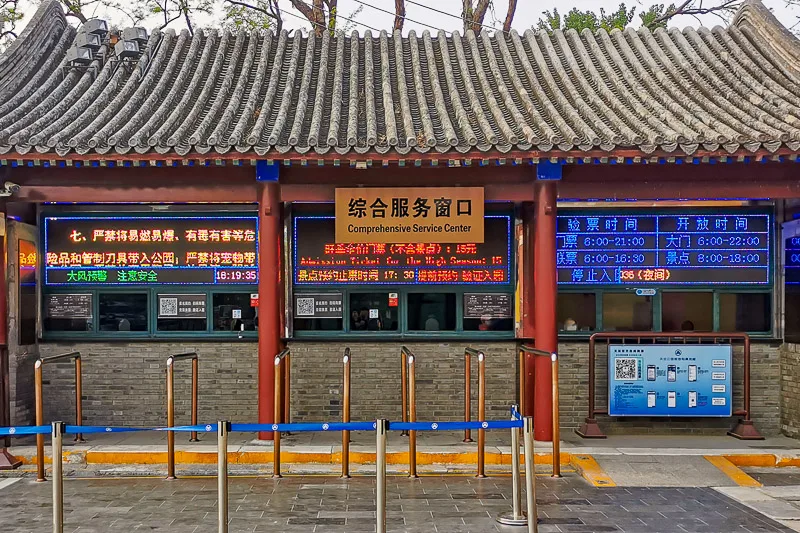
Temple of Heaven has 4 gates: North, East, South, West. All gates have ticket counter, so it doesn’t matter which gate you enter from. Personally, I prefer to enter from East Gate because of 2 reasons.
First, there’s a subway station right at East gate, and it’s called Tiantandongmen (Line 5). Second, the East gate is just a short walk to the main building which is the Hall of Prayer for Good Harvest.
For your reference, below are all the possible ways to get to each gate of Temple of Heaven.
East Gate:
- Take Metro Line 5, get off at Tiantandongmen Station, and exit Exit A.
- Take Bus No. 6, No. 34, No. 35, No. 36, No. 39, No. 41, No. 43, No. 60, No. 72, No. 116, No. 128, No. 599 and get off at Fahua Temple Station;
- Take Bus No. 54 , 957, 958 and get off at Tiantan Stadium Station.
South Gate:
- Take bus no. 36, No. 53, No. 62, No. 122, No. 525, No. 958, No. 141, No. 200 Inner Ring, No. 200 Outer Ring, and get off at the South Gate of the Temple of Heaven.
West Gate:
- Take Metro Line 8, get off at Tianqiao Station, and exit Exit C.
- Take Bus No. 2, No. 20, No. 36, No. 53, No. 71, No. 72, No. 90, No. 93, No. 120, No. 622, BRT No. 1 or No. 141, and get off at the West Gate of the Temple of Heaven.
North Gate:
- Take Bus No. 6, No. 34, No. 35, No. 36, No. 72, No. 106, No. 110 and get off at the North Gate of the Temple of Heaven.
Temple of Heaven Brief History
The original Altar of Heaven and Earth was built in 1420 during Emperor Yongle’s reign. The main building was Hall of Prayer for Good Harvests, which was initially used for sacrificial ceremonies to worship both Heaven and Earth.
In 1530, Emperor Jiajing decided that the worship for Heaven should be separated from Earth. Therefore, he built another Altar to the south, now named Circular Mound Altar, to worship Heaven. Thereafter, in 1534, the Altar of Heaven and Earth was renamed the Temple of Heaven.
During Emperor Qianlong’s reign, the Temple of Heaven complex was reconstructed and renovated at a large scale around 1749.
In 1998, Temple of Heaven was inscribed by UNESCO as a World Heritage Site. Temple of Heaven is regarded as a masterpiece of ancient Chinese culture, a one-of-a-kind Altar to worship the Heaven.
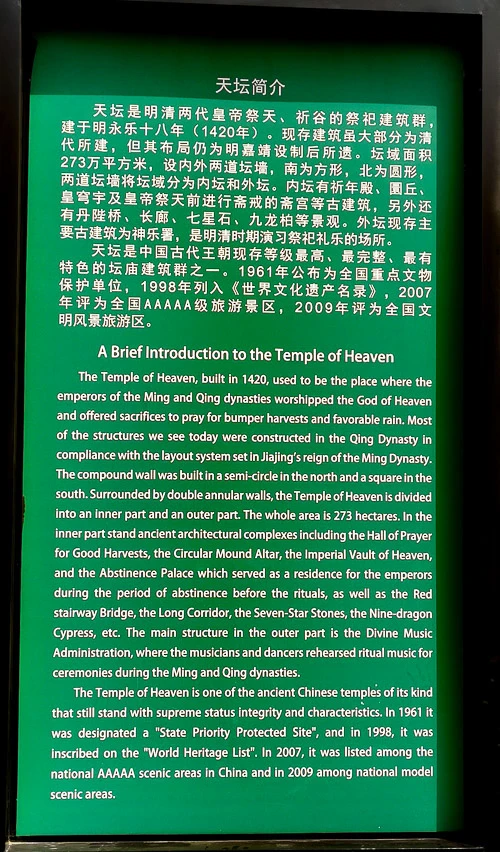
Temple of Heaven Map
Suggested Itinerary & Route
Before visiting Temple of Heaven, I would recommend that you plan your itinerary in advance, so that you don’t miss out the important landmarks.
Everyone has different availability and preference, some only has 2 hours for Temple of Heaven, while others have a full day. So, I have worked out 3 possible itineraries & routes that you can consider.
If you can’t decide how many hours to spend at Temple of Heaven, I think it’s totally worth it to designate an entire day for Temple of Heaven, because the Temple has a rich history and there are plenty of interesting and beautiful spots within the temple compound.
Essentials-Only Itinerary (2 hours)
- Start at North or East Gate
- Visit Hall of Prayer for Good Harvest
- Walk along Danbi Bridge towards the south
- Visit Imperial Vault of Heaven, Echo Wall, Circular Mound Altar
- Exit at South Gate
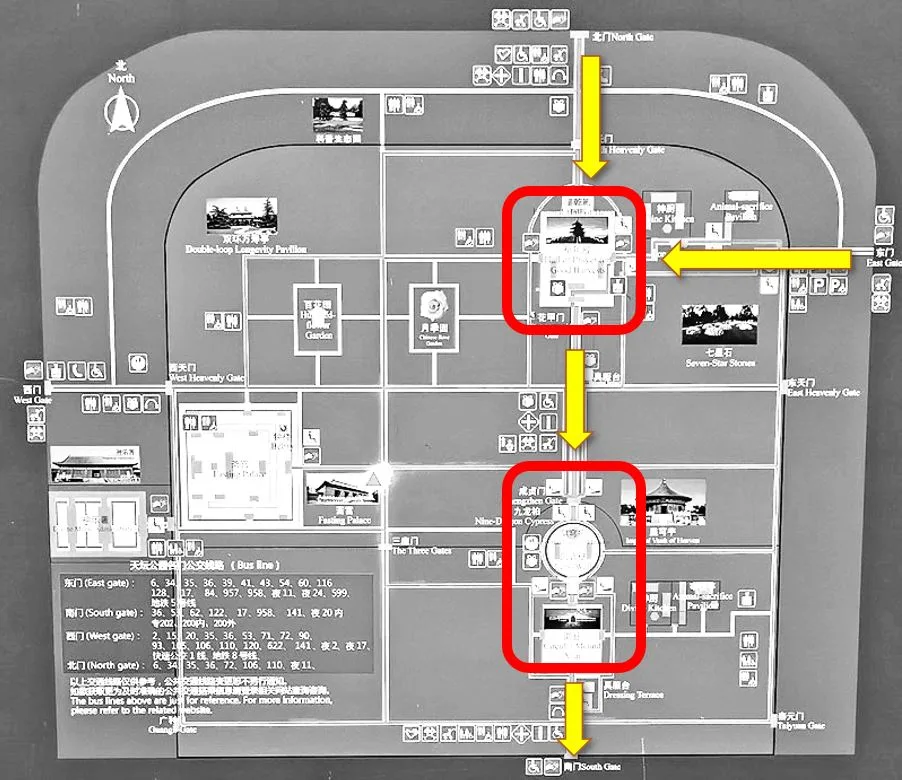
Half Day Itinerary (3-4 hours)
- Start at North or East Gate
- Visit Hall of Prayer for Good Harvest
- Walk along Danbi Bridge towards the south
- Visit Imperial Vault of Heaven, Echo Wall, Circular Mound Altar
- Walk towards the west
- Visit Fasting Palace, Divine Music Administration
- Exit at West Gate
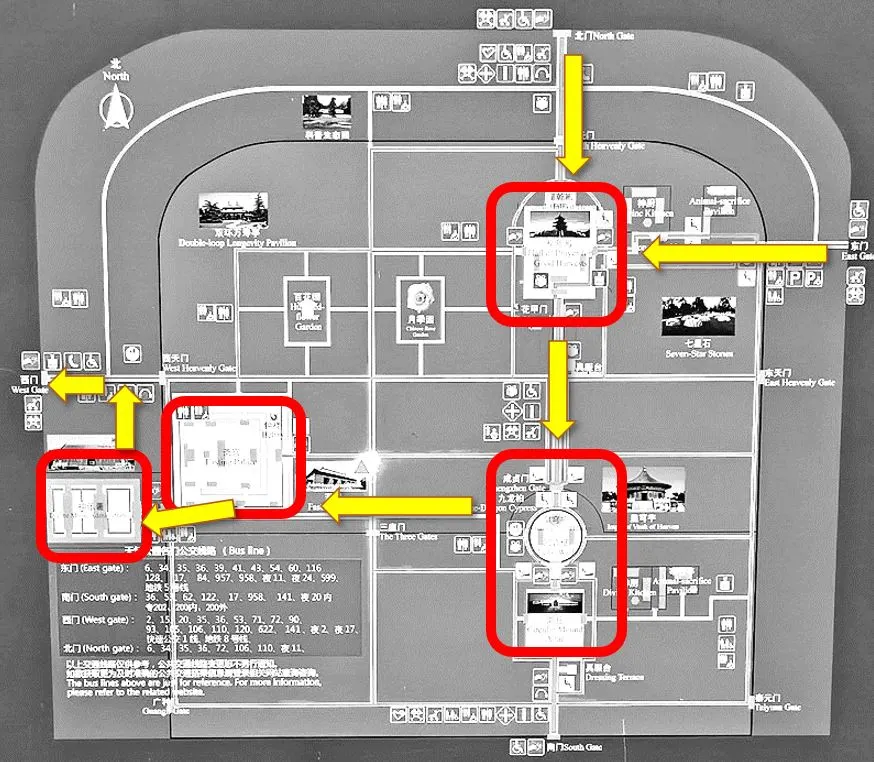
Full Day Itinerary (5-6 hours)
- Start at East Gate
- Visit Long Corridor, Divine Kitchen, Animal Sacrifice Pavilion and Seven-Star Stones
- Visit Hall of Prayer for Good Harvest and explore the indoor exhibitions
- Walk along Danbi Bridge towards the south
- Visit Imperial Vault of Heaven, Echo Wall, Circular Mound Altar
- Have lunch at one of the 2 restaurants in Temple of Heaven (read “What to Eat at Temple of Heaven” further in this article)
- Visit Fasting Palace, Divine Music Administration
- Stroll along Hundred Flower Garden and Rose Garden
- Visit the Double Ring Longevity Pavilion
- Exit at West Gate
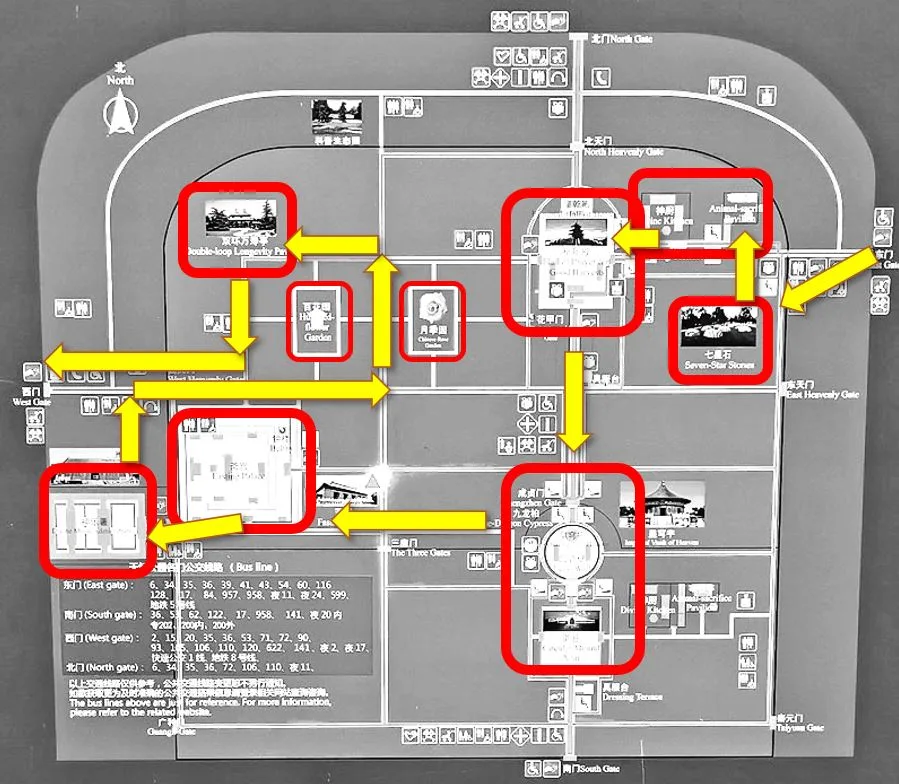
Renting Audio Guide
If you are visiting Temple of Heaven on your own, without joining a tour, but you want to learn history of the temple, you can rent an audio guide. We rented one ourselves, so I can share my experience with you.
The audio guide counters are available at all 4 gates: North Gate, East Gate, South Gate and West Gate. The cost of audio guide rental for foreign language is RMB 40, however you need to pay additional RMB 50 deposit which is refundable when you return audio guide at the end of the day.
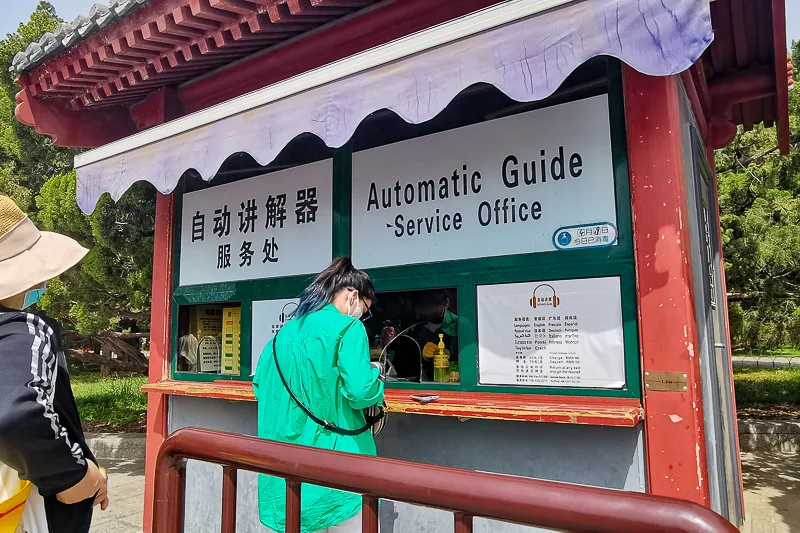
There are plenty of foreign language available, such as English, French, Spanish, Dutch, Portuguese, Italian, Indonesian, Thai, Vietnam, Japan, Korea, Arab, Czech.
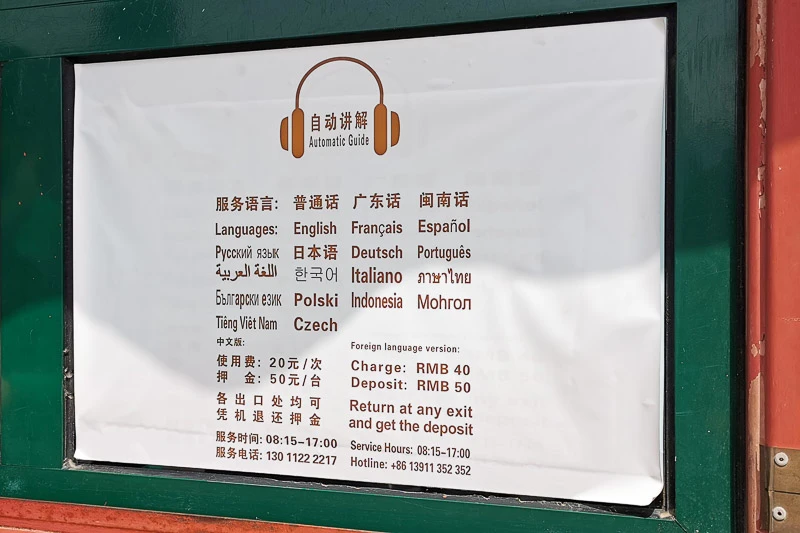
During our rental, we encountered a problem with our audio guide (the sound stopped playing), so we called the hotline number at the back of the device. We were pleasantly surprised when they said they’d come to our place to meet us and exchange a new one for us. And he did arrive in about 10 minutes! I think it’ll be useful if you have a local SIM card when you’re in China.
One important thing you must remember to do is this: you must return your audio guide before the counter closes to collect your deposit back! We almost didn’t get our deposit back because we didn’t know the counter closes so early.
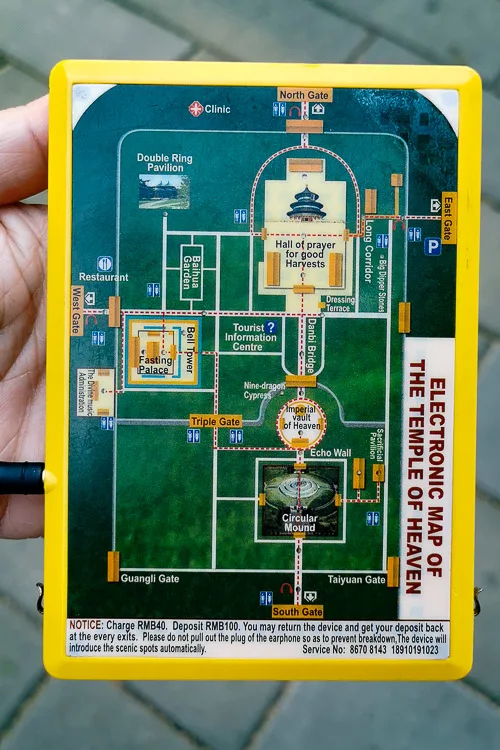
The temple compound is open until 10pm, we thought the audio guide counter is also open until 10pm, but it’s not. The counter is officially open until 5pm only. We returned the audio guide at 6pm and the counter was in the midst of closing! Thankfully we got lucky and managed to get our deposit back!
What to Do and See at Temple of Heaven
1. Hall of Prayer for Good Harvest
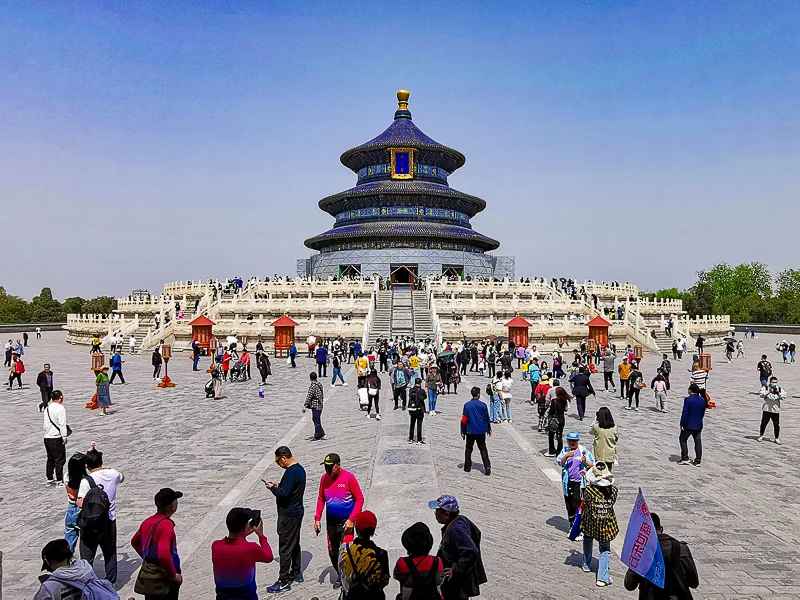
Hall of Prayer for Good Harvest is the main building at Temple of Heaven. If you only have time to visit one landmark in Temple of Heaven, this is where you should visit. The nearest gates from Hall of Prayer for Good Harvest are the North Gate and the East Gate.
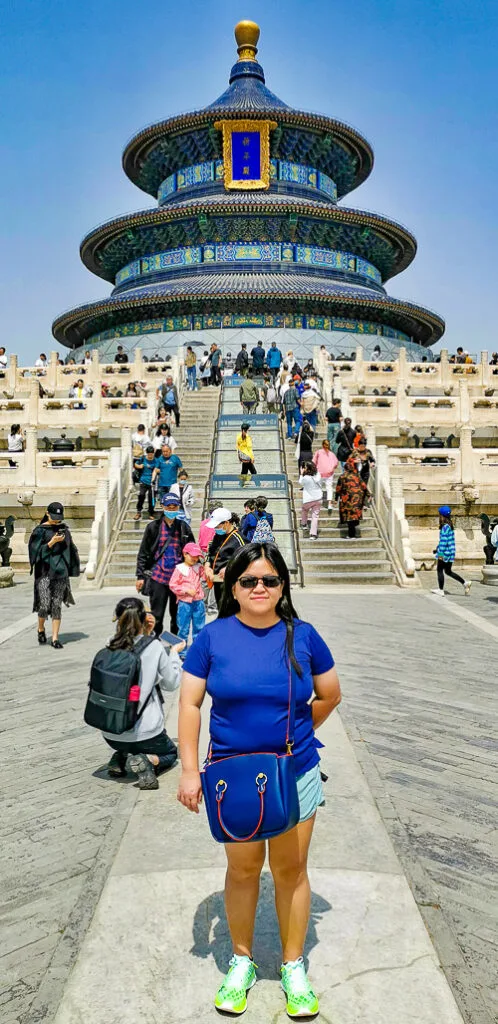
To enter Hall of Prayer for Good Harvest, you need a through ticket, which can be purchased from the ticketing counter at the 4 gates of Temple of Heaven. A general admission ticket doesn’t entitle admission to this Hall.
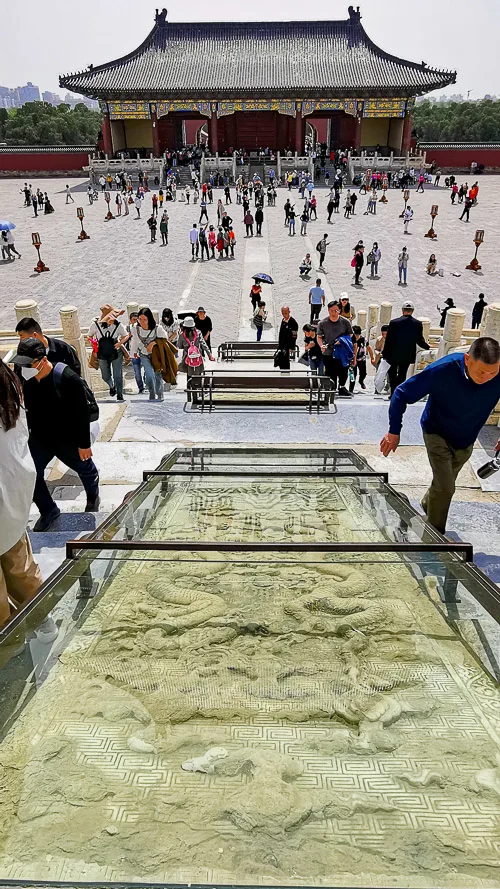
Hall of Prayer for Good Harvest is a circular wooden structure with 3 levels of roof. There are a total of 28 columns: 4 inner pillars symbolize 4 seasons, the middle 12 pillars symbolize 12 months, and the outer 12 pillars symbolize 12 nos of 2 hours in a day.
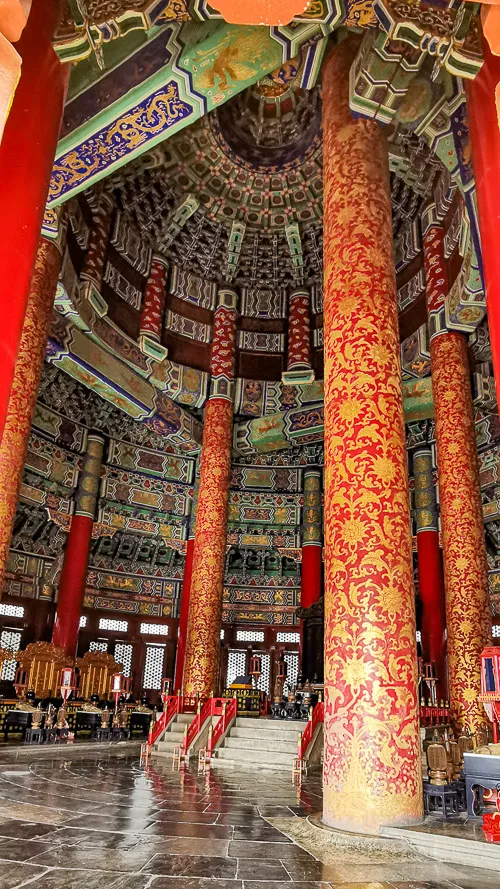
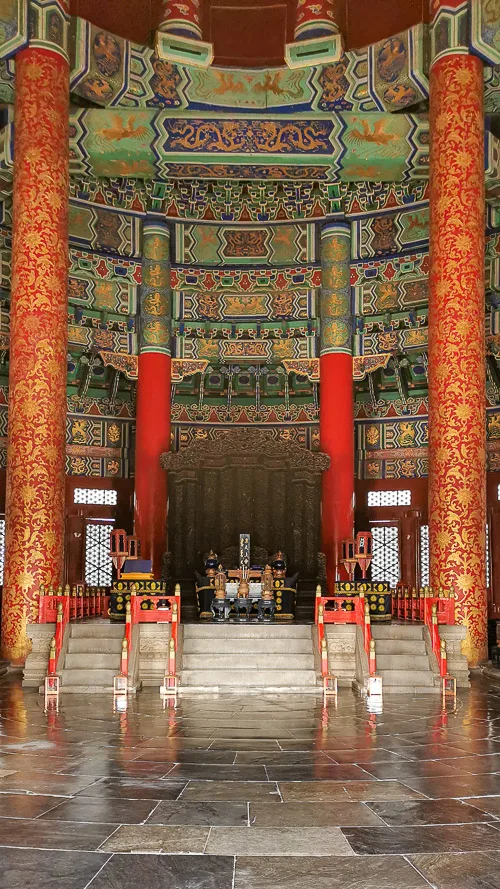
In its early years, Hall of Prayer for Good Harvest was used for sacrificial ceremonies to worship Heaven and Earth. A century later, Hall of Prayer for Good Harvest was used only to worship Earth, as the Heaven worship ceremony moved to Circular Mound Altar.
At the back of Hall of Prayer for Good Harvest is the Imperial Hall of Heaven.
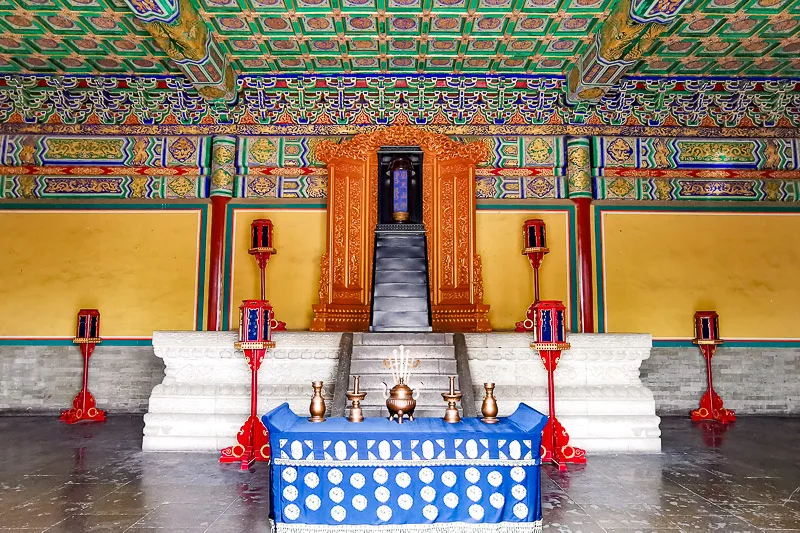
There are 2 exhibition galleries at the two buildings located at southeast and southwest of the Hall of Prayer for Good Harvests, where you can see miniature models of the Hall of Prayer for Good Harvest, as well as learn the history of the temple. Do not skip this!
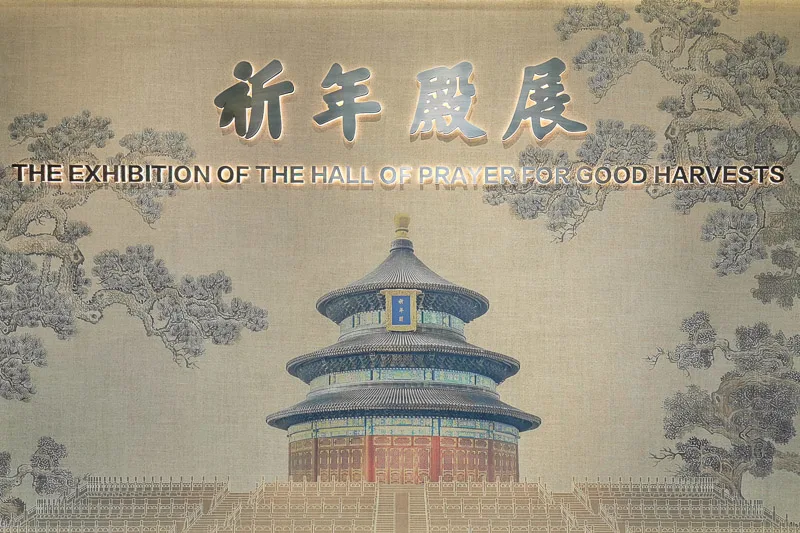
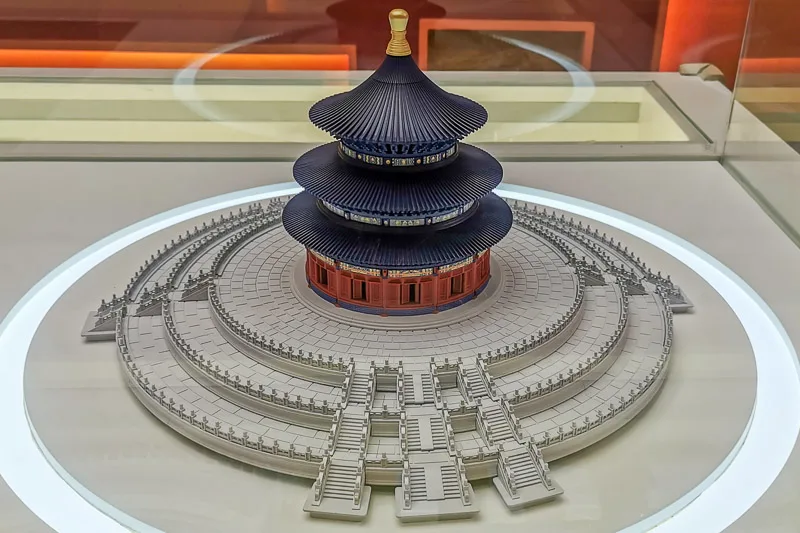
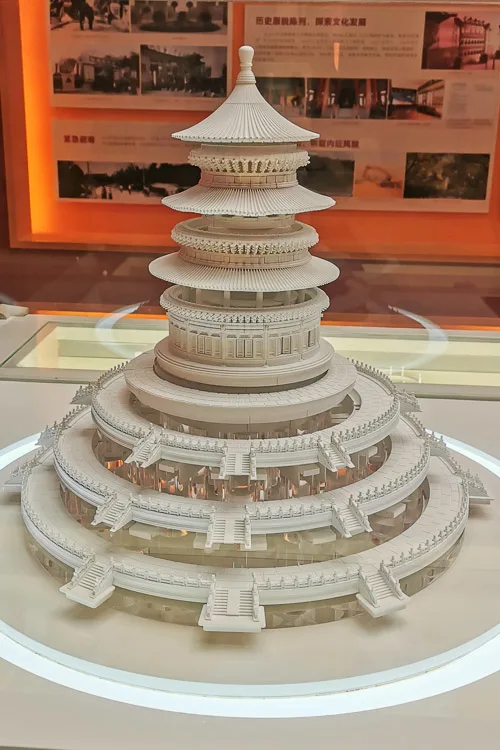
At the east of the Hall of Prayer for Good Harvest stood the Long Corridor, the North Divine Kitchen and North Animal-Sacrifice Pavilion. Offerings were prepared here before sacrificial ceremonies began.
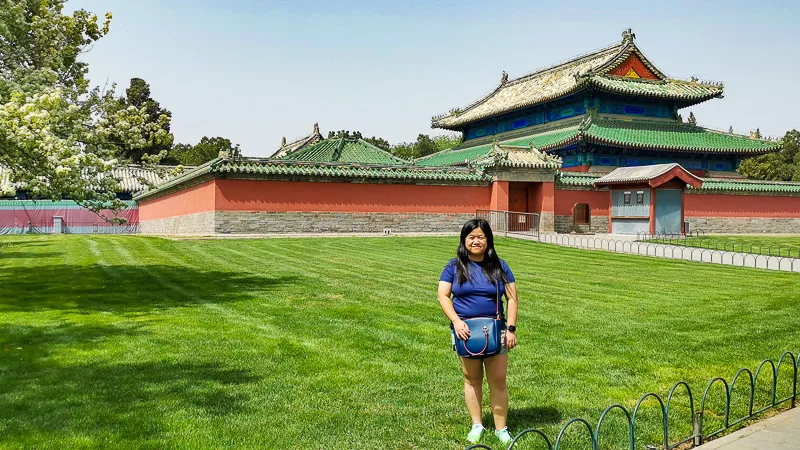
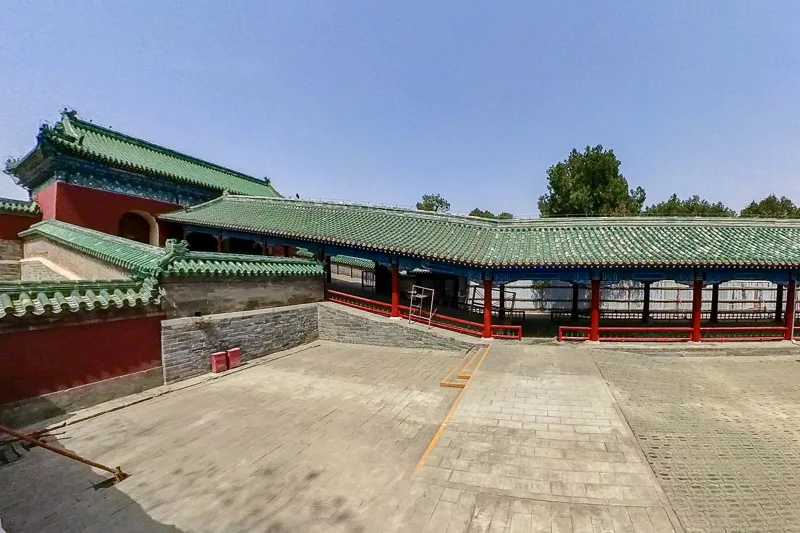
2. Danbi Bridge
Danbi Bridge is an elevated bridge that connect Hall of Prayer for Good Harvest at its north and the Circular Mound Altar at its south. Danbi Bridge is the oldest overpass in the ancient capital of Beijing.
Danbi Bridge is 360m long, 4m high and 30m wide. The road is brick-paved and unsheltered; an umbrella might come in handy during summer.
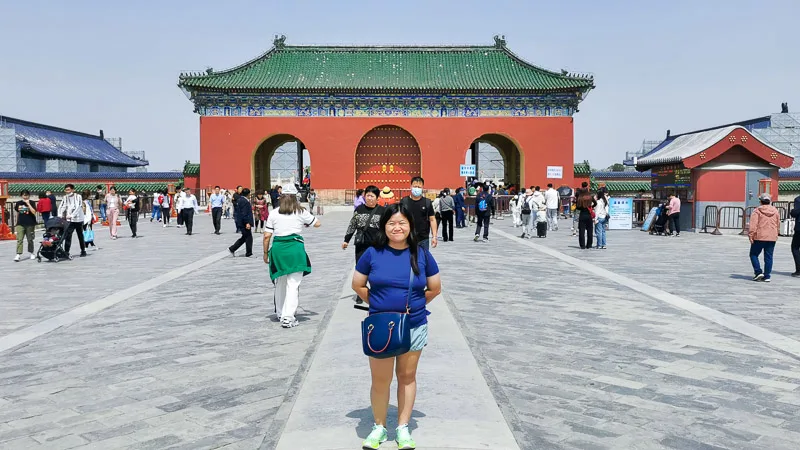
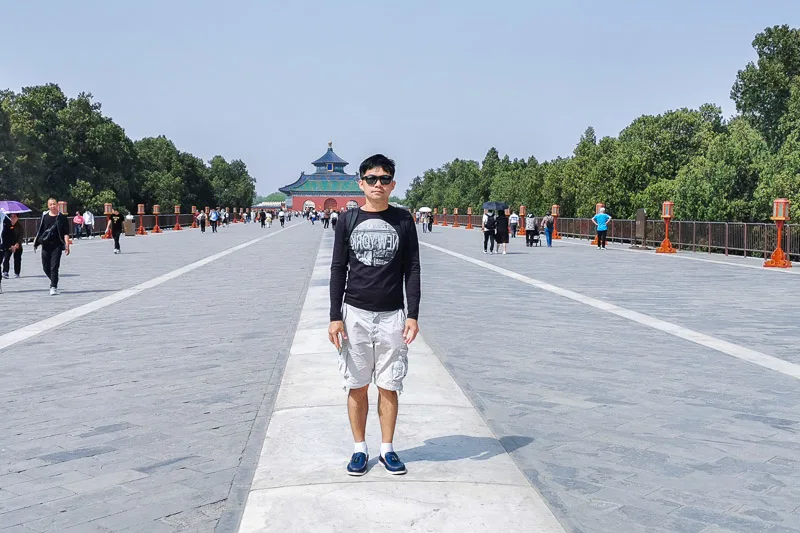
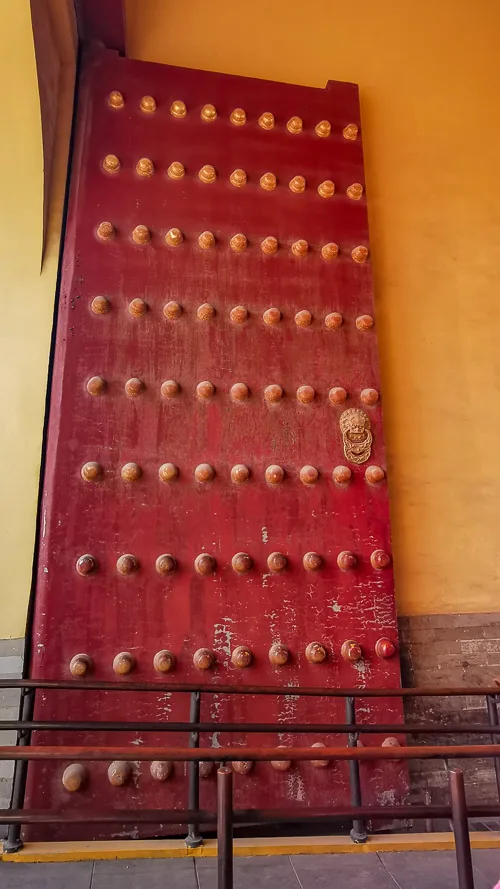
3. Imperial Vault of Heaven
Imperial Vault of Heaven is a circular structure that looks like a mini version of Hall of Prayer for Good Harvest, given its color and the shape of the roof.
Located at the south of Danbi Bridge, the Imperial Vault of Heaven is surrounded by the Echo Wall. It was used to keep the Heavenly Great Tablet, as well as many imperial ancestral tablets.
During my visit, Imperial Vault of Heaven was renovated (sadly).
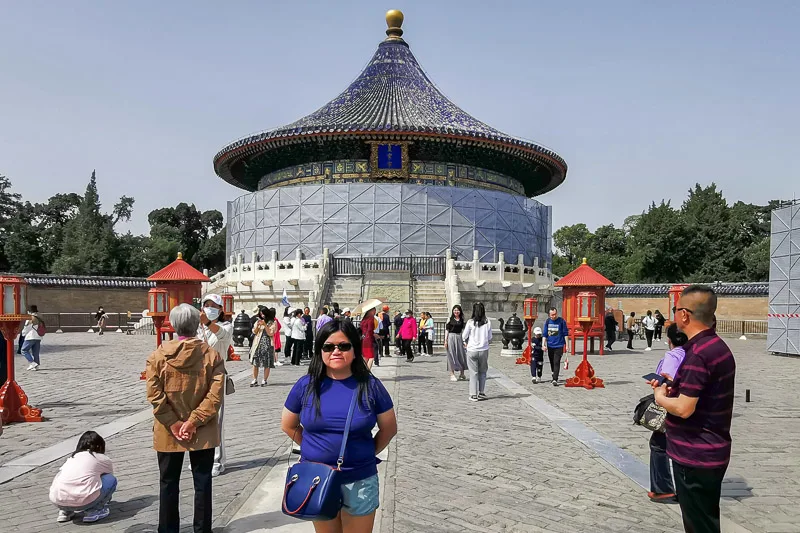
4. The Echo Wall
The Echo Wall is a circular wall surrounding Celestial Warehouse. The wall has an excellent transmission capability. If two people stand by the wall behind East Annex Hall and West Annex Wall respectively, and they speak while facing the north, they can hear each other clearly.
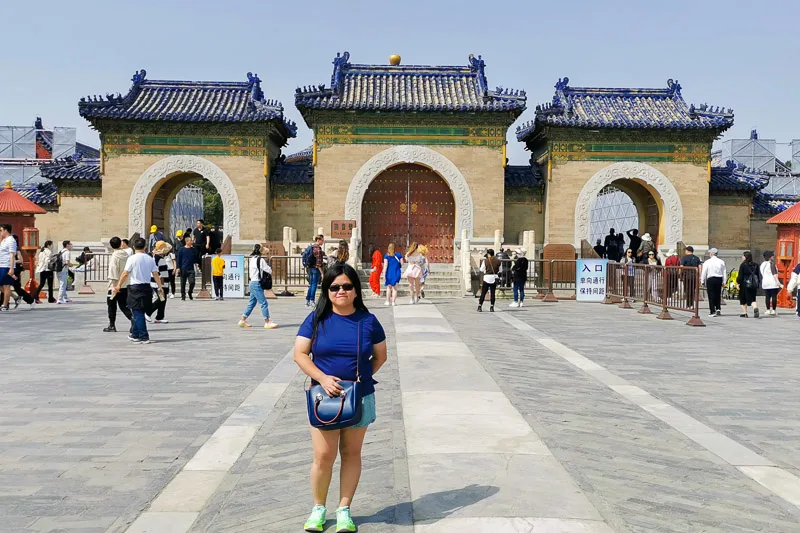
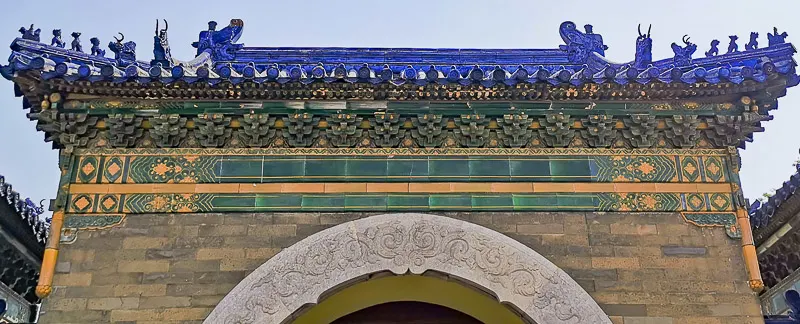
5. The Circular Mound Altar
As the name suggests, the Circular Mound Altar is a circular elevated terrace that was used to worship the Heaven. Built in 1530 by Emperor Jiajing of Ming dynasty, the altar is made of white marble and is enclosed by two walls; the inner circular wall symbolizes heaven while the outer square wall symbolizes the earth.
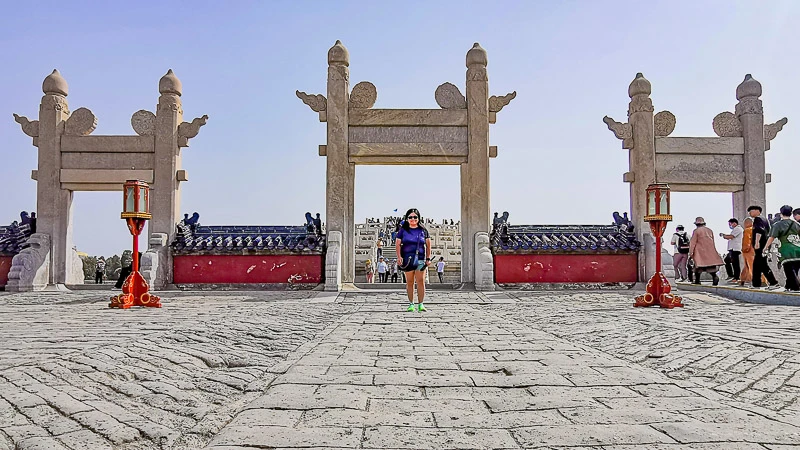
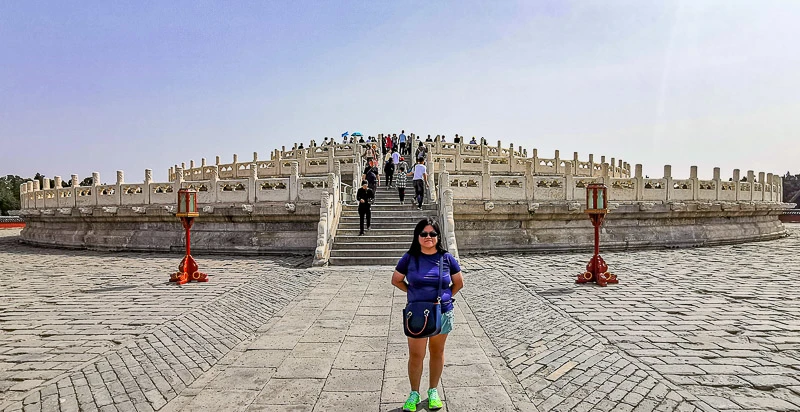
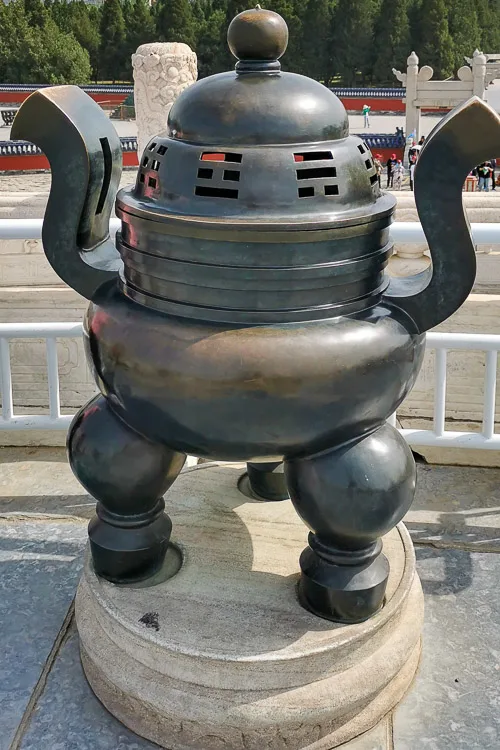
The Circular Mound Altar is divided into three levels. At the uppermost terrace, the center of the altar is a round stone slab called the Heavenly Center Stone, where the emperor would pray for good weather and bountiful harvests. If one speaks while standing on the Heavenly Centre Stone, his voice will be particularly resonant and sonorous.
At the uppermost terrace, the floor is made up stone slabs arranged in 9 circles/rings. The innermost circle has 9 pieces of stones, the second ring has 18 pieces of slab, and so on until the ninth circle that has 81 pieces of slab. The fascination with number 9 stems from Chinese belief that 9 is the highest single-digit number.
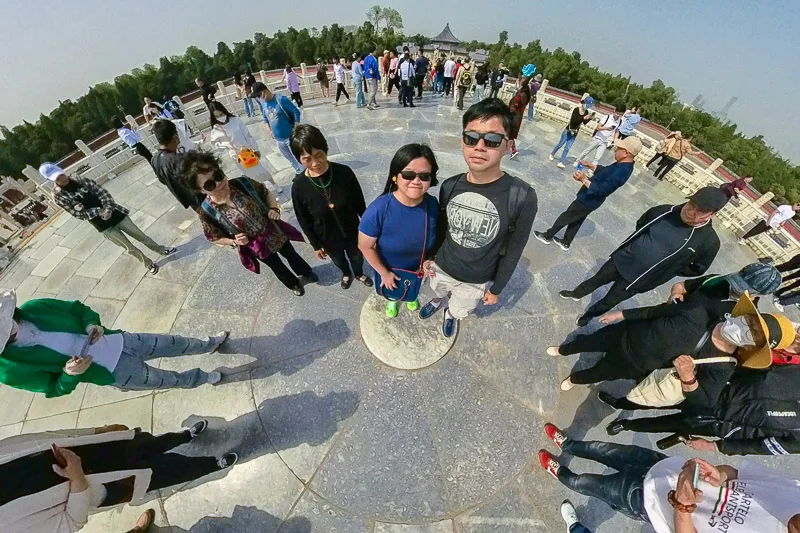
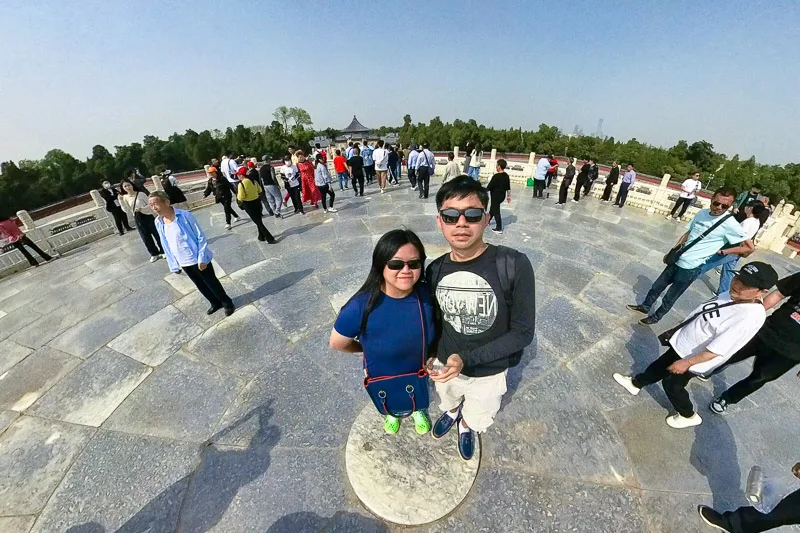
At the east of the Circular Mound Altar stood the South Divine Kitchen and South Animal-Sacrifice Pavilion. Offerings were prepared here before sacrificial ceremonies began.
6. The Fasting Palace / Hall of Abstinence
The Fasting Palace is also referred as Hall of Abstinence. The emperor would spend three days in the Fasting Palace abstaining from food, alcohol, and entertainment, in preparation for the sacrificial ceremony to Heaven.
The Fasting Palace has 3 gates: North, South and East. The main gate is the East Gate.
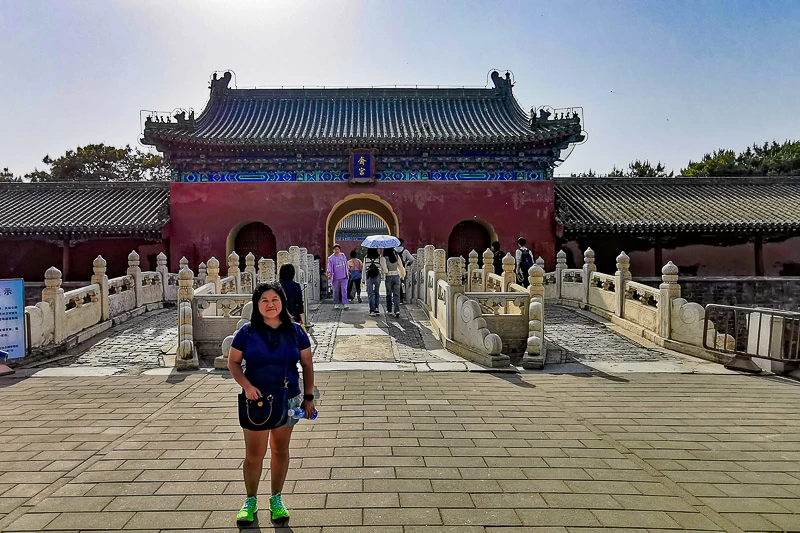
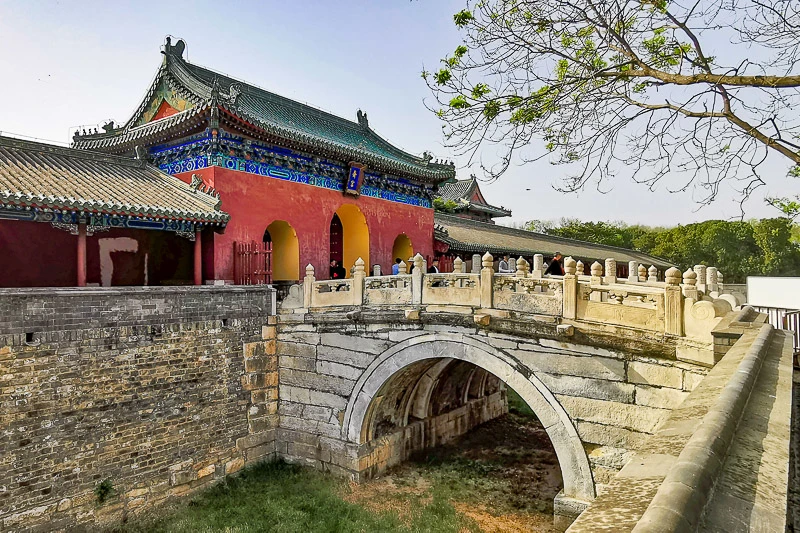
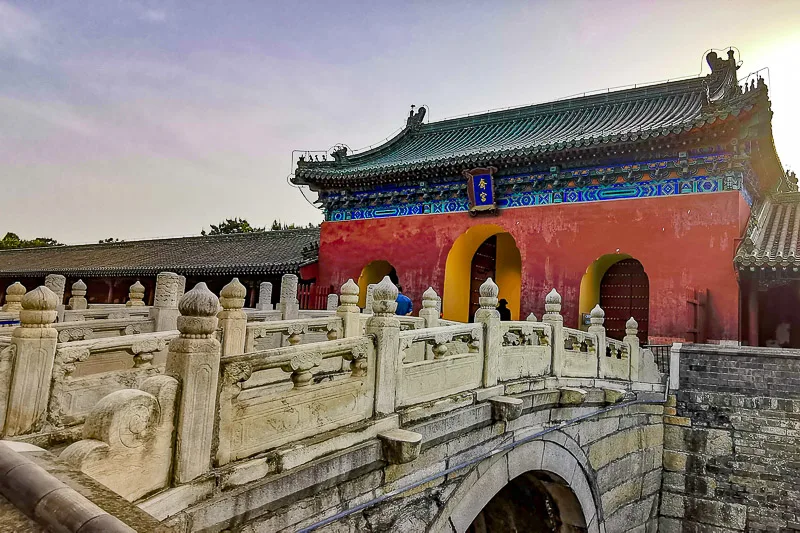
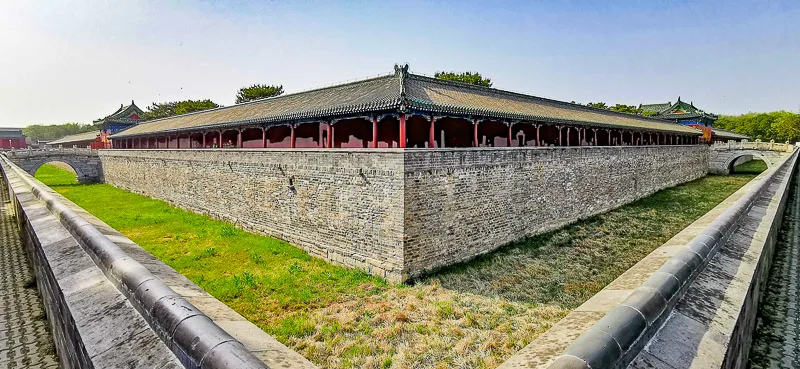
Upon entering East Gate, the first building you will see is the Beamless Hall, which is the main hall at the Palace. The Beamless Hall has no beams; it was used for ceremonial rituals in the past, but now it serves as exhibition galleries. During our visit, the hall was under renovation, unfortunately.
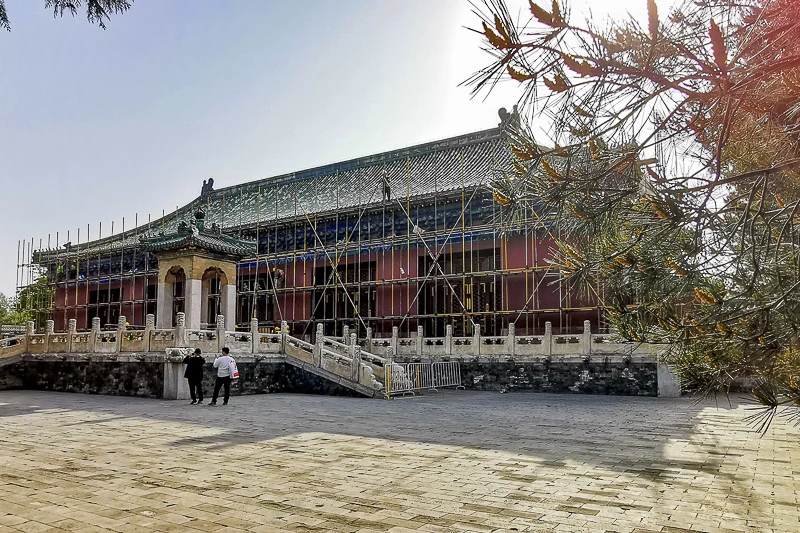
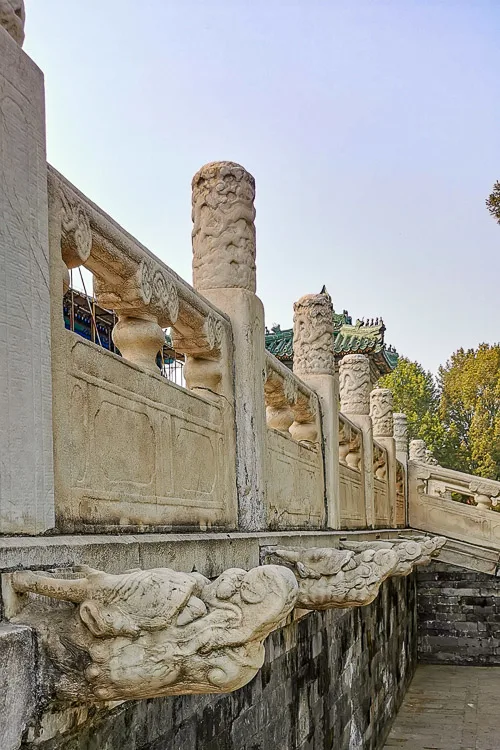
From East Gate, if you turn right, you will see the Belfry (or Bell Tower). The bronze bell in the Belfry was used to announce the arrival and departure of the Emperor each time.
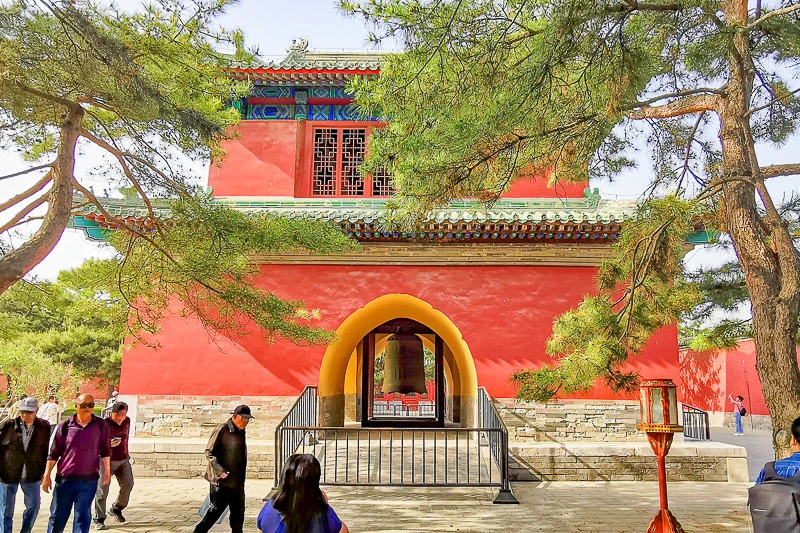
Behind the Beamless Hall is the Living Hall (also known as Bedroom Hall). This is the place where the emperor spent most of his time to practice abstinence before he held the sacrificial ceremonies. The hall has several rooms which serve different purposes, such as as reception room, bedroom, living room, and study room.
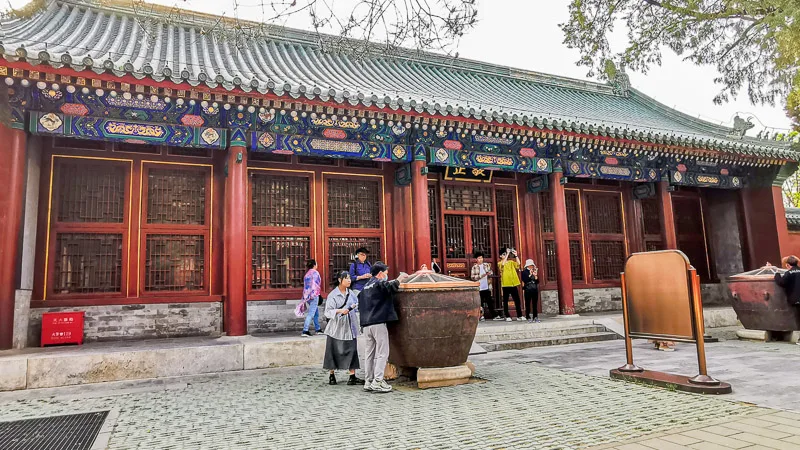
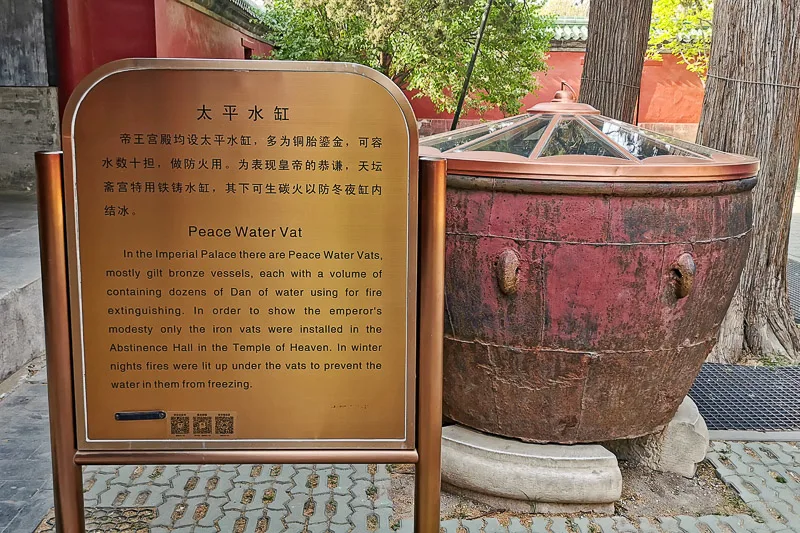
At both sides of the Living Hall are two Guard Rooms. At the back of the Living Hall is the Room of Prince.
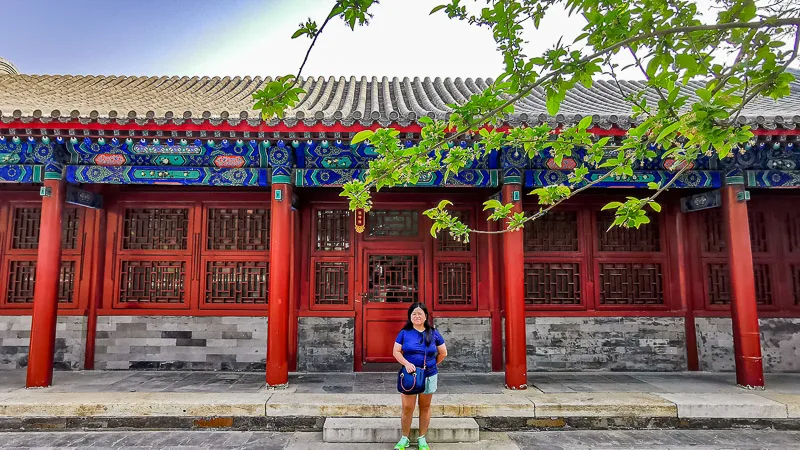
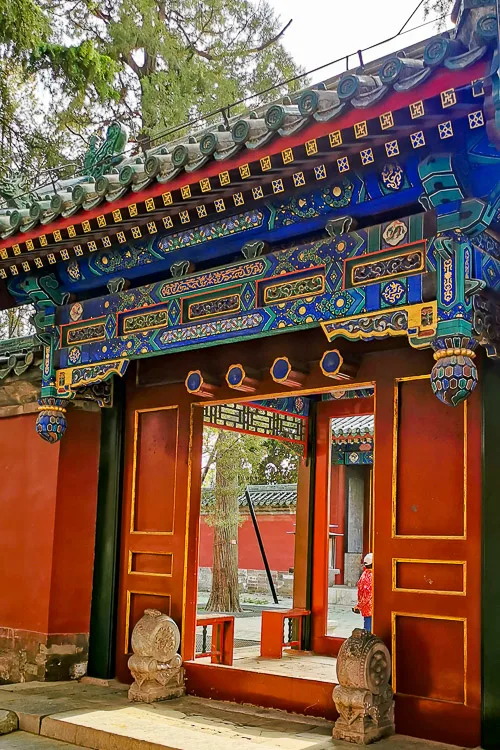
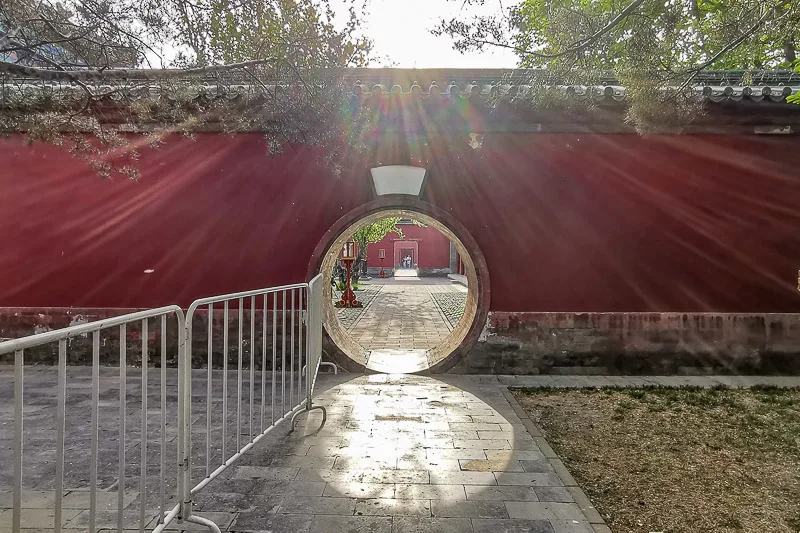
7. Seven-Star Stones
The seven-star stones symbolize the seven peaks of Mount Tai, a famous sacred mountain in China. These stones were engraved with motifs of mountains, and were placed at Temple of Heaven during Emperor Jiajing’s region.
These stones are located to the south of the North Animal-sacrifice pavilion, near East Gate. Because of its short height, it can be easily missed out, so keep a lookout at the ground!
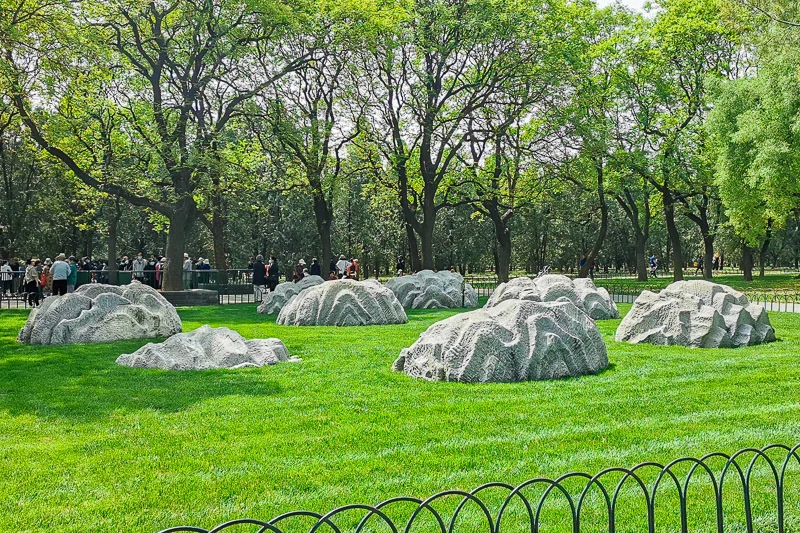
8. Baihua Garden & Rose Garden
Baihua Garden and Rose Garden are open-field gardens filled with flowers, benches and pavilions. It’s a great place to wind down after spending a long day at Temple of Heaven.
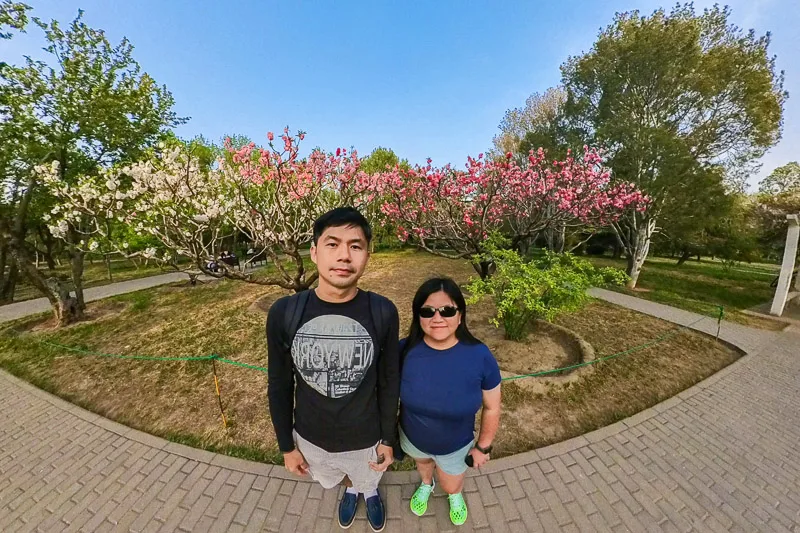
9. Double Ring Longevity Pavilion
Double Ring Longevity Pavilion is one of the lesser-visited places in Temple of Heaven, but I highly recommend that you do not skip it because it is a beautiful spot. When you are here, it feels like you’re in the middle of a Chinese garden!
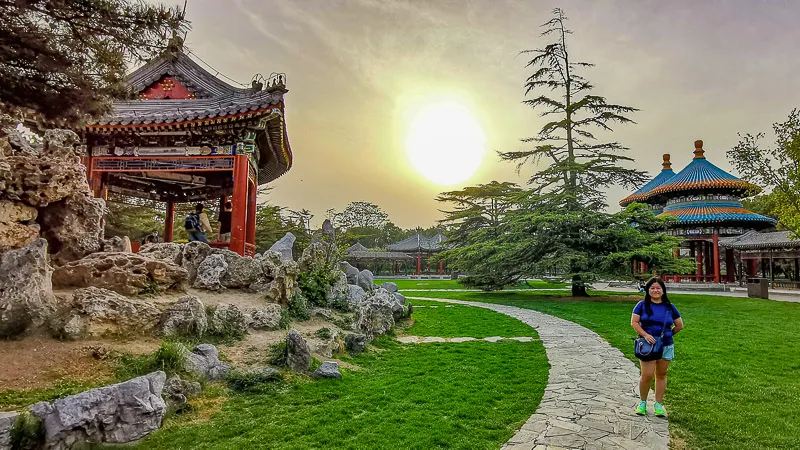
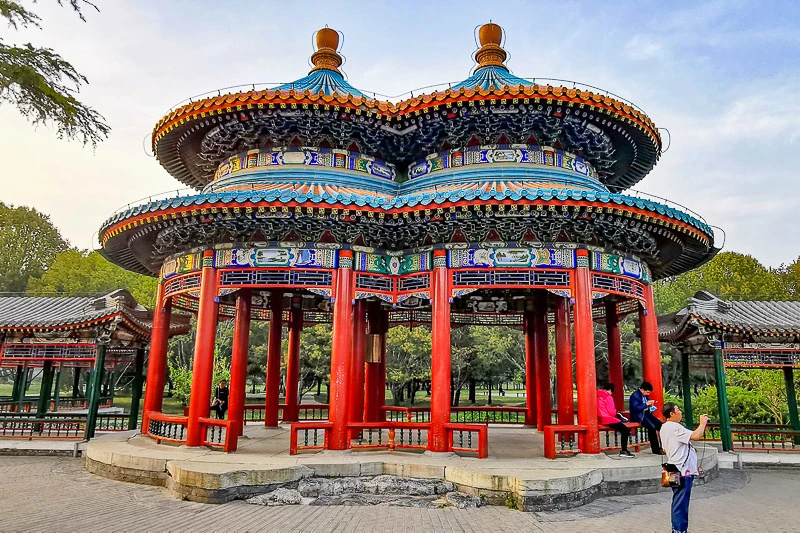
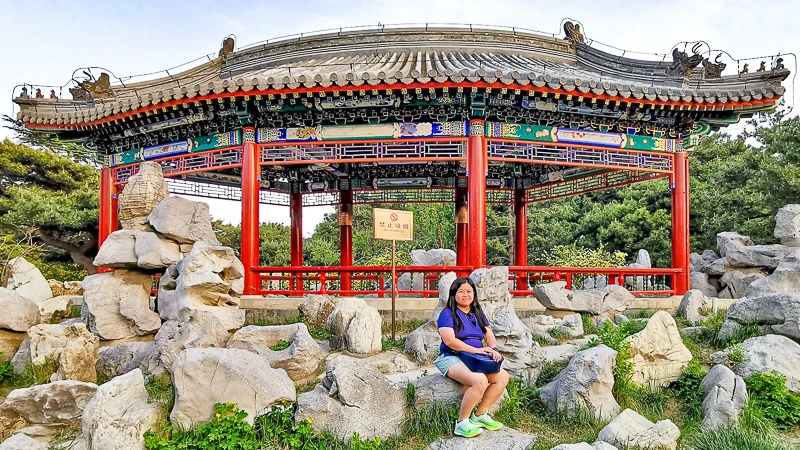
10. Divine Music Administration
Located near West Gate, Divine Music Administration was the most prestigious ritual music academy during imperial China responsible for training and managing ritual music and dance performers, as well as keeping ceremonial musical instruments.
Divine Music Administration is now a museum displaying musical instruments, ceremonial costumes, portraits and sculptures of famous ancient Chinese musicians.
Unfortunately, I missed out this building when visiting Temple of Heaven, sigh! Hence, no photos!
11. Take a stroll along the paths in Temple of Heaven
Lastly, take a stroll along the idyllic walking paths in Temple of Heaven and enjoy the present moment. It’s so much different from the hustle and bustle of a big city that Beijing is.
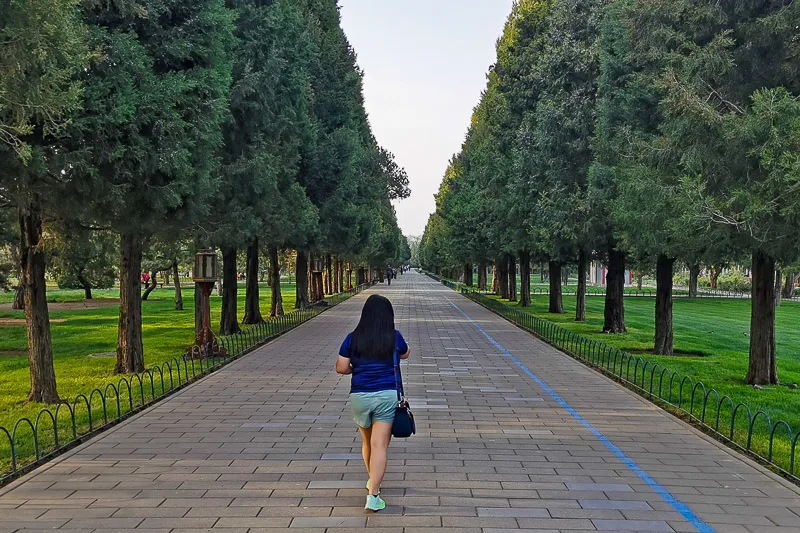
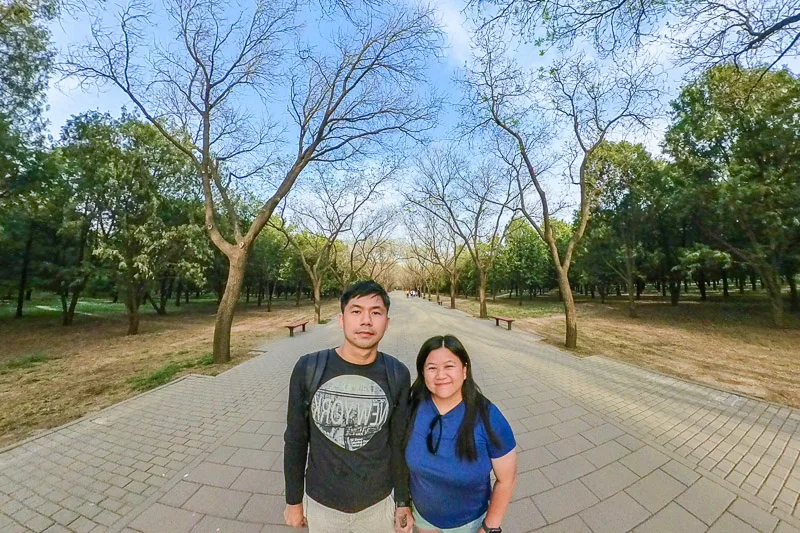

What to Eat at Temple of Heaven
1. Tiantanweidao (Taste of Temple of Heaven)
Located near Echo Wall and Circular Mound Altar, Tiantanweidao is one of the 2 restaurants located inside Temple of Heaven.
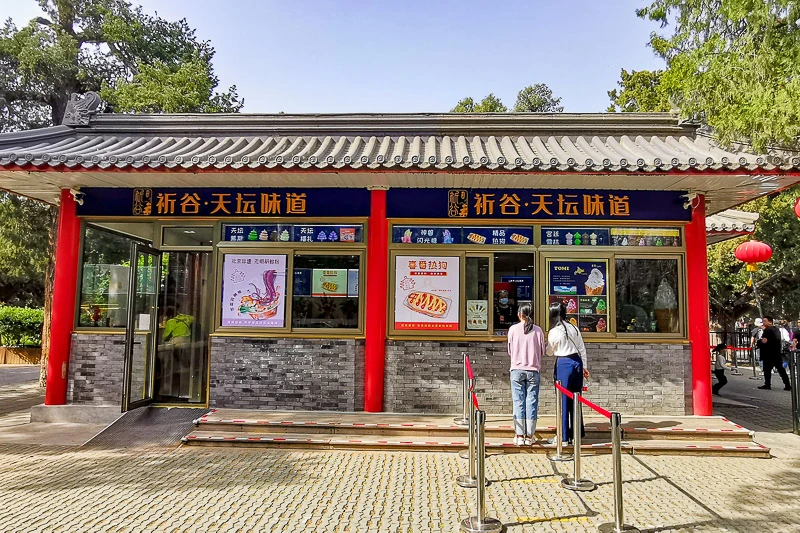
It is a small café selling noodle dishes and rice dishes, as well as beverages and the iconic Temple of Heaven ice cream. We had the signature potato roast beef rice (RMB39), and a 550ml bottle of mineral water (RMB5).
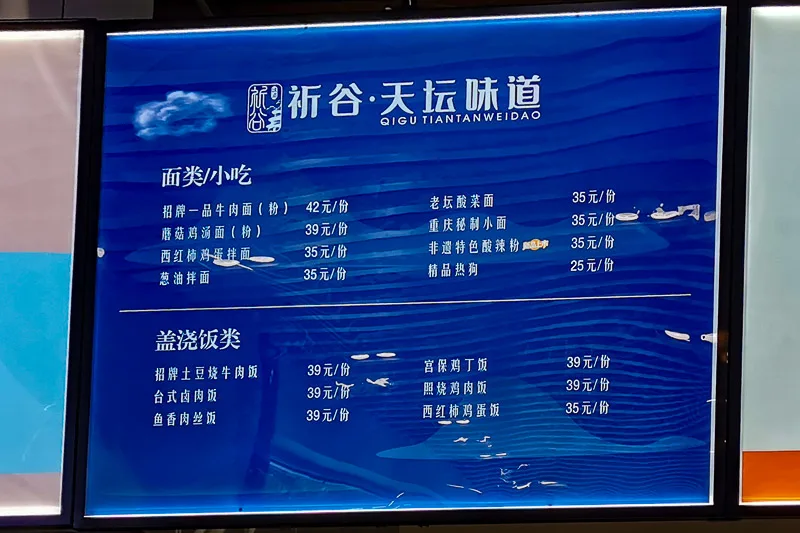
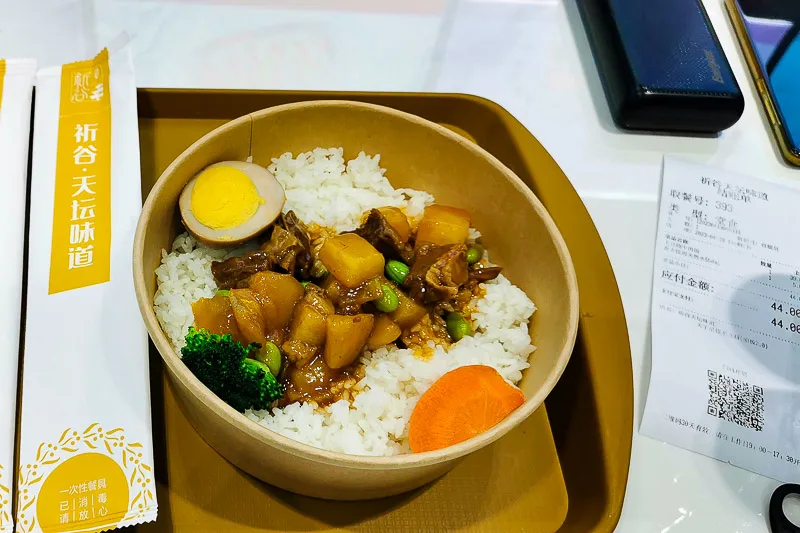
2. Minyuan Restaurant (Tiantanfuyan / Temple of Heaven Fortune Banquet)
Located near west gate, Minyuan Restaurant is a proper restaurant with both indoor and al-fresco seating. They sell breakfast, main course, dessert and cakes.
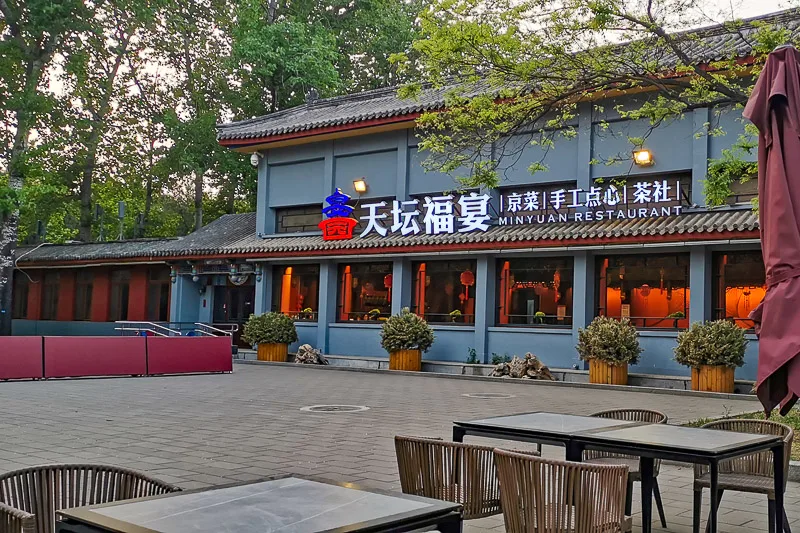
Other Information
There are plenty of vending machines scattered throughout Temple of Heaven and they accept mobile payments, such as WeChatPay and AliPay.
Final Thoughts
Phew! Over 3,000 words!! I didn’t plan to write such a long article! I hope my long article inspires you to spend a whole day exploring Temple of Heaven slowly, because this temple sure has plenty of gems for you to uncover.
Any comment, tips or feedback is welcomed in the comment section below!
If you like my work, you can buy me a coffee! Your support will help me to keep going!

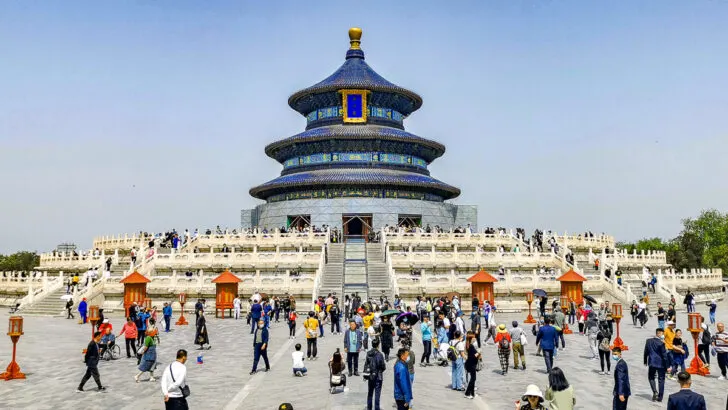
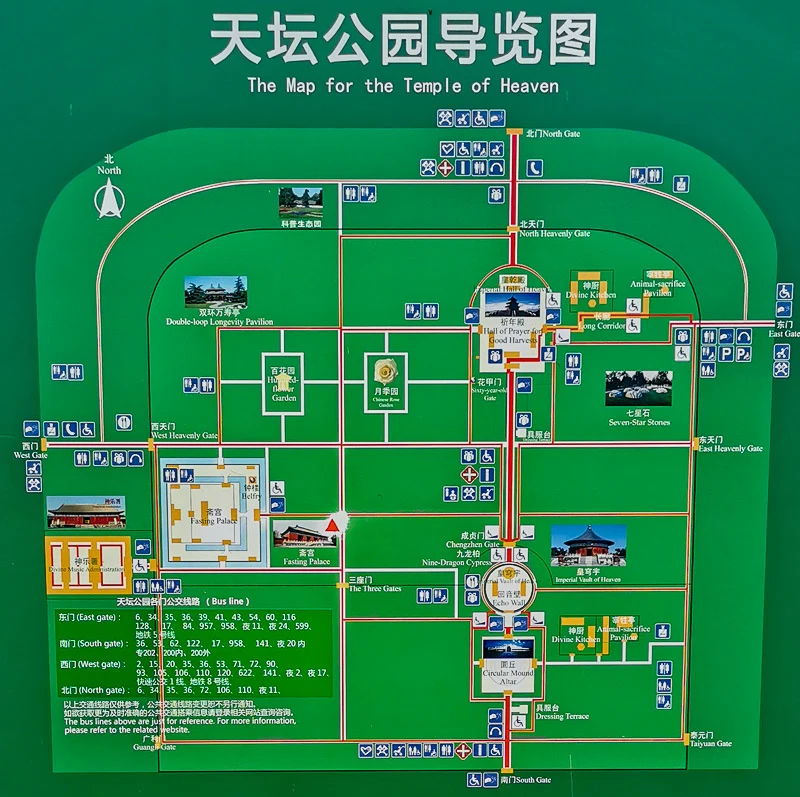
Ronald
Friday 13th of October 2023
Hi Eva! Do you if now it's necessary to make reservations in advance to visit Temple of Heaven? Or it's still possible to just buy the tickets at one of the entrances? Thank you!
Eva
Saturday 14th of October 2023
Hi Ronald, during my visit, it wasn't necessary to book in advance, we just paid at the entrance. I'm not sure if things have changed now that China started seeing more visitors.